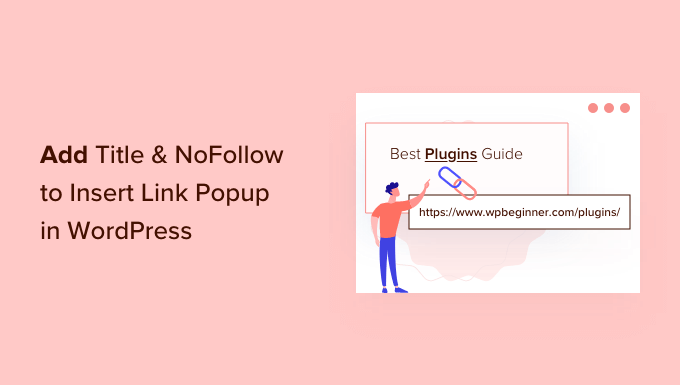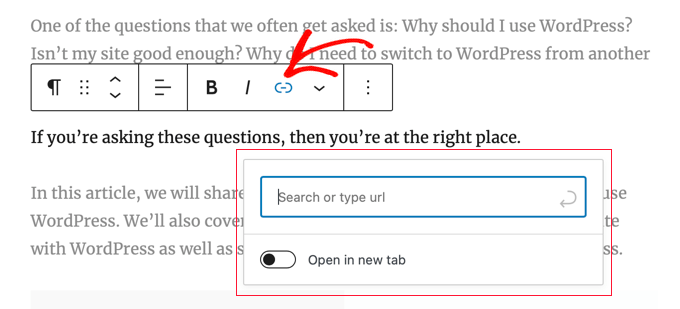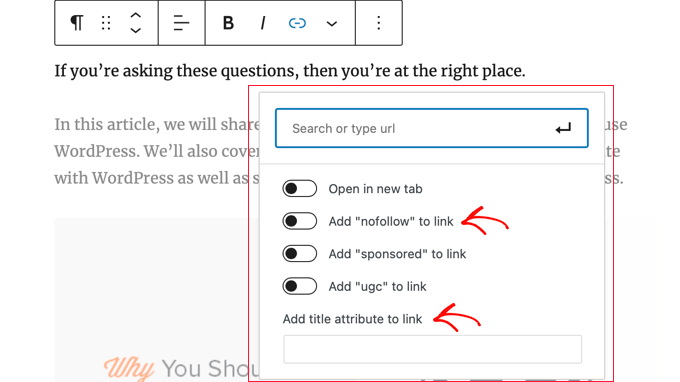Volete aggiungere un tag title o nofollow ai vostri link su WordPress?
Per impostazione predefinita, WordPress non fornisce un modo per aggiungere gli attributi title e nofollow quando si creano link con l’editor di blocchi di WordPress.
In questo articolo vi mostreremo come aggiungere opzioni per gli attributi title e nofollow al popup Inserisci link di WordPress.

Perché aggiungere gli attributi Title e NoFollow ai link in WordPress?
Quando scrivete un contenuto, potete aggiungere dei link per interconnettere i vostri post e le vostre pagine WordPress e fare riferimento ad articoli di altri siti. Questi collegamenti ipertestuali indicano ai visitatori del vostro sito WordPress dove possono trovare ulteriori informazioni su un argomento.
È utile dare un titolo ai link. Questo apparirà quando qualcuno punterà il cursore del mouse su un link.

Questo può essere rassicurante per i lettori, perché rende chiaro dove porta il link. Inoltre, migliora la SEO del vostro sito.
Gli esperti SEO raccomandano anche di utilizzare l’attributo nofollow quando si aggiungono link esterni ad altri siti web. Questo attributo indica ai motori di ricerca che possono scorrere questi link, ma non trasmettere alcuna autorità di collegamento a questi siti web.
Tuttavia, quando si fa clic sull’icona Inserisci link in WordPress, non ci sono opzioni per aggiungere un titolo al link o per rendere il link nofollow. Il popup consente solo di aggiungere l’URL del link e di aprire il link in una nuova finestra.

Detto questo, vediamo come aggiungere facilmente le opzioni title e nofollow al popup Inserisci link del vostro blog WordPress.
Come aggiungere titolo e NoFollow al popup Inserisci link in WordPress
La prima cosa da fare è installare il plugin gratuito All in One SEO Lite. Per maggiori dettagli, consultate la nostra guida passo passo su come installare un plugin di WordPress.
All in One SEO (AIOSEO) è il miglior plugin SEO per WordPress e vi aiuta a migliorare la SEO del vostro sito web. La versione gratuita è sufficiente per aggiungere attributi extra al popup Aggiungi link, ma AIOSEO Pro offre ancora più funzioni per aiutarvi a posizionarvi meglio nelle pagine dei risultati dei motori di ricerca.
Dopo l’attivazione, è necessario configurare il plugin utilizzando la configurazione guidata di AIOSEO. Per istruzioni dettagliate, consultate la nostra guida definitiva su come configurare All in One SEO per WordPress.
Una volta fatto ciò, il plugin aggiungerà automaticamente degli attributi extra al popup che appare quando si fa clic sul pulsante Inserisci collegamento.
Questi includono un campo per il titolo e opzioni per aggiungere tag nofollow, sponsorizzati e UGC (contenuti generati dagli utenti).

Per aggiungere il titolo del link, basta digitarlo nel campo “Aggiungi attributo titolo al link”. Quando si salva il link, AIOSEO applica il titolo e tutti gli attributi attivati.
Guide esperte per l’aggiunta di link in WordPress
Ora che sapete come aggiungere gli attributi title e nofollow ai link, vi consigliamo di consultare le nostre migliori guide su come creare, monitorare e correggere i link sul vostro sito WordPress:
- Guida per principianti su come aggiungere un link in WordPress
- Link interni per la SEO: La guida definitiva alle migliori pratiche
- I migliori plugin di collegamento interno per WordPress (automatici e manuali)
- Come tracciare i clic sui link e sui pulsanti in WordPress (in modo semplice)
- Come trovare e correggere i link rotti in WordPress (passo dopo passo)
Speriamo che questo tutorial vi abbia aiutato a capire come aggiungere le opzioni title e nofollow al popup Inserisci link di WordPress. Potreste anche voler consultare la nostra guida su come velocizzare le prestazioni di WordPress o la nostra scelta di esperti dei plugin indispensabili per far crescere il vostro sito.
Se questo articolo vi è piaciuto, iscrivetevi al nostro canale YouTube per le esercitazioni video su WordPress. Potete trovarci anche su Twitter e Facebook.





Syed Balkhi says
Hey WPBeginner readers,
Did you know you can win exciting prizes by commenting on WPBeginner?
Every month, our top blog commenters will win HUGE rewards, including premium WordPress plugin licenses and cash prizes.
You can get more details about the contest from here.
Start sharing your thoughts below to stand a chance to win!
Dennis Muthomi says
Quick question….you mentioned that SEO experts recommend using a nofollow attribute to external links.
I have a slightly different approach – the only external links that I add nofollow attributes to are affiliate links. If I’m linking out to a helpful resource like a government site (.gov), or a statistics webpage, I always use a dofollow link.
my thinking is that for truly valuable and authoritative sources, I want to pass on some link juice rather than using a nofollow.
What’s your take on this? Should I just have nofollow on all external links like most SEOs recommend, or does my method of selectively applying nofollow make sense?
WPBeginner Comments says
Generally, it’s recommended to set all external links to “nofollow” for safety, and then when you have a high quality resource, you can use “dofollow”. There is no one size fits all, it just depends on your needs.
Dennis Muthomi says
thank you for the clarification!
makes sense to me to use nofollow as a default for external links, but allow some dofollow juice to flow to really authoritative sites when it adds value for readers.
appreciate you taking the time to clarify – solid advice as always from the WPBeginner team!
Jiří Vaněk says
I would like to ask, within the scope of SEO, if I want only external links to have the nofollow attribute. Leave internal links as they are, but set nofollow indiscriminately for all external links. I want this in order for the robot on my website not to follow external links. How to solve it? Through a snippet of code or a plugin?
WPBeginner Support says
We have a guide on how to nofollow external links that you should find helpful below
https://www.wpbeginner.com/plugins/how-to-nofollow-all-external-links-in-wordpress/
Admin
Stuart says
Hi there,
It’s worth noting this won’t work in the Gutenberg editor.
Cheers.
WPBeginner Support says
We’ll be sure to look into updating this article
Admin
Editorial Staff says
The article has been updated to reflect a new solution which works in both Gutenberg as well as classic editor.
Admin
Kulwant says
can this plugin slow down over website speed ?
WPBeginner Support says
Hi Kulwant,
No, it doesn’t affect site speed.
Admin
Bikramjit says
Hi,
I have added link of some research journals, they are like authorities. Should I keep those link as nofollow link.
best regards
Bikramjit
John says
I read this article today and installed the plugin, but it hasn’t been updated for the last 2 years?
Is it still a safe and good plugin to use then? Or is there a better one by now?
I have seen quite some nofollow plugins but none that include the Title as well.
Any advice would be nice :).
Great article!
WPBeginner Support says
Hi John,
We reached out to the plugin author and they have updated the plugin. You can now safely install it on your website.
Admin
Jasmin says
Hi, great tutorial!!! Can you please tell me how you added the hyperlink to the “Editorial Staff” text beneath the title?
Theodore Nwangene says
This is really a very awesome tutorial,
I understand how important it is to nofollow our external links especially when its an affiliate link and thats what made this post amazing.
A friend was just asking me the other day how to easily make a link nofollow now, which other way will be easier than what you just explained here?
I’m going to forward this post to him right away and will also download the plugin as soon as possible.
Thanks for sharing.
Viacheslav says
Isn’t that simpler to add rel=”nofollow” and title manually when adding the link in the TEXT mode? I usually do this with no bother
WPBeginner Support says
Yes you can do that too if you find it more convenient.
Admin
Barry Richardson says
Am I assuming correctly that each link on a blog would have to be individually set? After all, we might want to “do-follow” some outbound links and “no-follow” others – or we might want to link to a different post on the same site, which typically should be “do-follow”.
WPBeginner Support says
Yes this is why this plugin is helpful. You can leave the nofollow box unchecked if you want to create a dofollow link.
Admin
John D says
I’very never understood why WP by default has no title attribute to set in its link dialog. Blogger had it in 2008!
WPBeginner Support says
WordPress had it too. It was removed in WordPress 4.2.
Admin
Olivia Smith says
Do we have to change HTML setting individually for every blog we post ?
WPBeginner Support says
No, unless you want to.
Admin
Connor Rickett says
The real question is, Why isn’t this isn’t a default feature in WordPress?
I mean, all it needs is a little checkbox in the link section, follow/nofollow, and, poof, powerful new feature. No muss, no fuss, barely any tears.
Mark Corder says
“but you don’t want to pass away any link authority to these websites.” …
What exactly is meant by that?
Atila says
It means that you don’t want search engines to pick up that link while crawling. The link is there for reference or for whatever reason, and you are not giving him your PR juice. It would be bad to have a website full of dofollow outbound links, especially if they lead to poor content website. Only leave clean links to sites that you care of and are important.
Gulshan says
Please make a list of Perfect plugin to manage all over SEO.